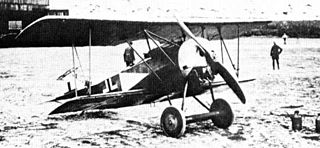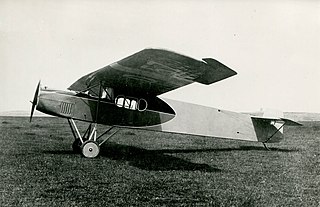
The Fokker Dr.I, often known simply as the Fokker Triplane, was a World War I fighter aircraft built by Fokker-Flugzeugwerke. The Dr.I saw widespread service in the spring of 1918. It became famous as the aircraft in which Manfred von Richthofen gained his last 17 victories, and in which he was killed on 21 April 1918.

The Fokker D.VII is a German World War I fighter aircraft designed by Reinhold Platz of the Fokker-Flugzeugwerke. Germany produced around 3,300 D.VII aircraft in the second half of 1918. In service with the Luftstreitkräfte, the D.VII quickly proved itself to be a formidable aircraft. The Armistice ending the war specifically required, as the fourth clause of the "Clauses Relating to the Western Front", that Germany was required to surrender all D.VIIs to the Allies. Surviving aircraft saw much service with many countries in the years after World War I.

The Fokker E.V was a German parasol-monoplane fighter aircraft designed by Reinhold Platz and built by Fokker-Flugzeugwerke. The E.V was the last Fokker design to become operational with the Luftstreitkräfte, entering service in the last months of World War I. After several fatal accidents due to wing failures, the aircraft was modified and redesignated Fokker D.VIII. Dubbed the Flying Razor by post-war pulp-fiction writers, the D.VIII had the distinction of scoring the last aerial victory of the war.

The Sopwith Triplane is a British single seat fighter aircraft designed and manufactured by the Sopwith Aviation Company during the First World War. It has the distinction of being the first military triplane to see operational service.

A triplane is a fixed-wing aircraft equipped with three vertically stacked wing planes. Tailplanes and canard foreplanes are not normally included in this count, although they occasionally are.

The Deutsche Luftstreitkräfte – known before October 1916 as Die Fliegertruppen des deutschen Kaiserreiches – was the air arm of the Imperial German Army. In English-language sources it is usually referred to as the Imperial German Air Service, although that is not a literal translation of either name. German naval aviators of the Marine-Fliegerabteilung were an integral part of the Imperial German Navy. Both military branches operated aeroplanes, observation balloons and airships.

The Fokker V.6 was a prototype fighter triplane developed in Germany during World War I in parallel with the V.5, from which the famous Dr.I was developed. The V.6 was powered by an 89 kW (120 hp) Mercedes D.II liquid-cooled engine. The heavier engine required larger wings, with the lower wing being placed just below the fuselage. A modification to add fairings to the lower wing fuselage junction was implemented after the first tests. The V.6 was abandoned in October 1917 due to being inferior in maneuverability to the newer Dr.I.

The Fokker V.7 was a prototype German fighter triplane of World War I, an attempt to improve upon the Dr.I by using the experimental Siemens-Halske Sh.III, double acting rotary engine.. To make use of the higher power and rpm, the aircraft had a four-bladed propeller of larger diameter than the Dr.I. This required longer landing gear. The rear fuselage had to be extended to compensate for the heavier engine. Four V.7 aircraft were built. The performance of the V.7 was outstanding, but the engine was not ready for service. The Fokker V.7/I was converted to a Dr.I.

The Fokker F.I was a prototype German fighter triplane design by Reinhold Platz of World War I. It was an improved version of the V.4 prototype triplane. For many decades, the V.5 was misidentified as the V.4.

The Fokker V.2 and V.3 aircraft were developed from the Fokker V.1, but utilized an 89 kW (120 hp) Mercedes liquid-cooled inline engine instead of the rotary. This is similar to the Fokker V.6 being tested as the Fokker V.5 was being developed. Like the V.1, the fuselage was circular in cross section, and the wings were covered with plywood. To match the center of pressure and center of gravity with the heavier engines, these aircraft had their upper wing's outboard sections swept back.

The Fokker D.VI was a German fighter aircraft built in limited numbers at the end of World War I. The D.VI served in the German and Austro-Hungarian air services.

The Fokker K.I, company designation M.9, was a German experimental biplane built during World War I by the Fokker-Flugzeugwerke. It was intended to meet a need by the Fliegertruppen des deutschen Kaiserreiches for an aircraft that could defend itself against Entente fighters armed with machine guns. Fokker had had only limited resources available for the project and Anthony Fokker, the company's owner and chief designer, could not devote a lot of time or material to the K.I, given the demands on his time and the company's resources. The limited flight testing conducted by Fokker revealed multiple problems with the aircraft's center of gravity and structural strength. Resolving these issues was beyond Fokker's resources at that time and he ordered the K.I scrapped.

The Fokker M 10 was a two-seater reconnaissance / trainer biplane with single-bay wings equipped with wing-warping controls for roll, powered by a 7-cylinder 80 hp Oberursel U.0 engine. Several M 10 aircraft were purchased by the Imperial and Royal Aviation Troops of Austro Hungary.

Fokker V.8 was a five-winged aircraft built by Fokker for the Luftstreitkräfte during World War I.

The Fokker F.II was the first of a long series of commercial aircraft from the Fokker Aircraft Company, flying in 1919. In a biplane age, it presented a distinct clean, high-wing monoplane style that sold successfully across Europe and North America during the development of commercial passenger-carrying aviation.

The Junkers CL.I was a ground-attack aircraft developed in Germany during World War I. Its construction was undertaken by Junkers under the designation J 8 as proof of Hugo Junkers' belief in the monoplane, after his firm had been required by the Idflieg to submit a biplane as its entry in a competition to select a ground-attack aircraft.

The Pfalz Dr.I was a German fighter prototype of World War I. Official interest in the potential of the triplane configuration for single-seat fighters prompted Pfalz to develop the Dr.I. It underwent initial testing in October 1917, and an initial batch of 10 aircraft were shipped to the Front and arrived in April 1918.
The Schütte-Lanz D.III was a German fighter prototype during World War I. It participated in the first Idflieg D competition at Adlershof, Germany in January and February 1918. It was a conventional single-bay staggered biplane with N-type interplane struts. Constructed of wood with fabric skinning, the D.III gave an unspectacular performance: production was never continued.

The Kondor D 7 was a prototype German single seat biplane fighter built over the winter of 1917-18. It was not a success and its development was soon abandoned.
The Hansa-Brandenburg W.17 was a German flying boat fighter of the World War I era, designed and built by Hansa-Brandenburg.


















